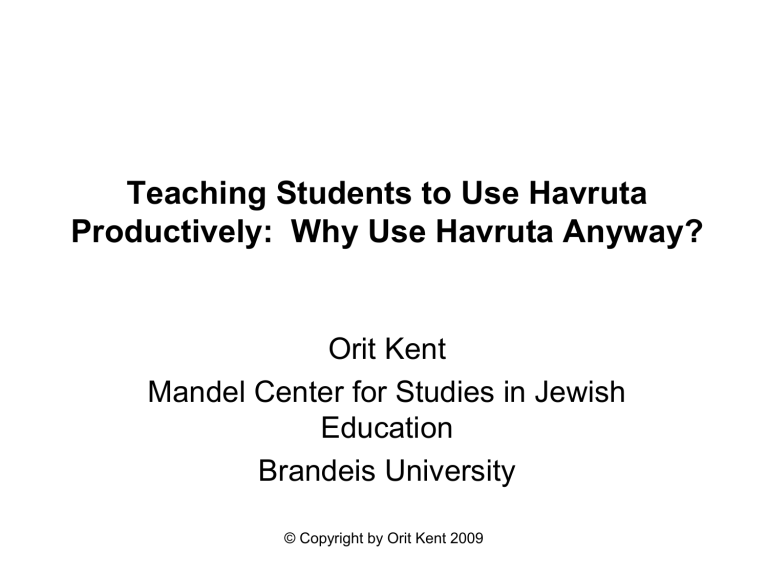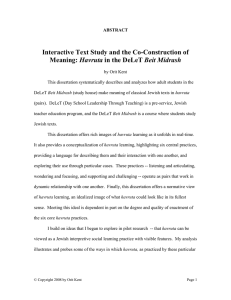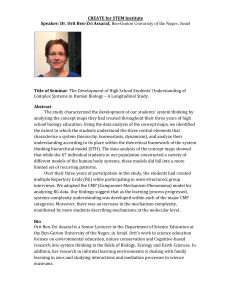Teaching Students to Use Havruta Productively: Why Use Havruta Anyway?

Teaching Students to Use Havruta
Productively: Why Use Havruta Anyway?
Orit Kent
Mandel Center for Studies in Jewish
Education
Brandeis University
© Copyright by Orit Kent 2009
Havruta
• When two people study Jewish texts together
• Entails making sense of texts with another person, often without a teacher’s direct guidance
© Copyright by Orit Kent 2009
Outline of Presentation
• Background
• Teaching Havruta in the DeLeT Beit
Midrash for Teachers (BMT)
Reconstruction of Lesson
Student Reflections
• Moving Havruta Work to the Next Level
© Copyright by Orit Kent 2009
" Experience does not go on simply inside a person…A primary responsibility of educators is…that they recognize…what surroundings
(or methods) are conducive to experiences that lead to growth."
--John Dewey, Experience and
Education
© Copyright by Orit Kent 2009
Using and Teaching Havruta in Jocelyn Segal’s 3rd Grade
Classroom
What messages about havruta is the teacher communicating?
What does she think havruta is good for?
© Copyright by Orit Kent 2009
Some Rationales for Using Havruta
• Havruta learning can be a way to access ideas from Jewish texts.
• Havruta learning can be an engaging way to study.
• Havruta learning is an appropriation of a "Jewish" mode of learning which brings with it a history and cultural resonance.
•
Havruta learning can provide students with a safe space to think through ideas before a more formal shiur or group discussion and thereby encourage broader student involvement.
• Havruta learning can help students arrive at rich, textually grounded interpretations by seeing different ideas in the text and considering their merits.
© Copyright by Orit Kent 2009
Havruta as a “Jewish Interpretive
Social Learning Practice”
• Jewish
• Interpretive
• Social
• Ethical
Which dimension are you trying to access?
© Copyright by Orit Kent 2009
Do you use havruta in your classroom?
• Why and how do you use it?
• What do you find challenging about using it?
© Copyright by Orit Kent 2009
Beit Midrash For Teachers
• Component of the DeLeT/MAT program, a preservice teacher education program
• Curriculum includes:
– Learning content of Jewish texts about teaching and learning
– Learning about the process of interpretation
– Learning how to “do” havruta
© Copyright by Orit Kent 2009
Six Havruta Practices (Kent, 2008)
Supporting
Wondering Focusing
Challenging
© Copyright by Orit Kent 2009
Why do students study in havruta in the BMT?
• Provides opportunity to practice and get better at interpreting the texts they are studying [interpretive]
• Provides an opportunity to practice and get getter at following, understanding and supporting someone else’s learning
(“critical colleagues”) [social and ethical]
© Copyright by Orit Kent 2009
Tools and Formats used to Teach
Havruta in the BMT
Pedagogi cal Form
Minilessons
Video analysis and transcripts
In-class exercises/ta sks
Assignments
Purpose Expose students to theoretica l foundation of havruta
Give students images of effective havruta
Help students develop facility with havruta practices
Raise student awareness of themselves as havruta learners
© Copyright by Orit Kent 2009
Overview of A Lesson on Havruta
Practices: Supporting and
Challenging
1. Mini-lesson introducing the practices of supporting and challenging
2. Text study in havruta to develop textual interpretations
3. Time in a new havruta to practice supporting and challenging and refining initial interpretations
4. Written reflections on the process of text study in havruta and/or in-class debrief
© Copyright by Orit Kent 2009
Key Ideas of Mini Lesson
• Supporting and challenging are key to learning with our havruta partners, colleagues and students.
• Challenging a fellow learner is especially difficult because it is countercultural.
• Supporting and challenging are part of the ethical dimensions of havruta learning.
© Copyright by Orit Kent 2009
Your role as a havruta is to:
1. actively listen to your colleague’s interpretation so that you are clear about what s/he is saying. You might ask the following questions: Am I understanding you correctly that you are reading this part of the text to mean
X?
2. probe your colleague’s interpretation by asking clarifying questions such as: you said X; how did you get to this idea?; You said X, could you tell me more about what you mean by that?
When you feel the need,, don’t hesitate to probe the answers to these questions as well.
3. support and reinforce your colleague’s interpretation by offering additional cues in the story and/or reasons which may support his/her interpretation. For example: Would you say that when it says X, this reinforces your point?
4. challenge the interpretation of your colleague by pointing to details in the story which the interpretation does not address or which may contradict the interpretation. For example, In the text it says X, how do you make sense of this part according to your interpretation How does that fit with what was just said? I don't really get that; could you explain it another way or give me an example?
5. offer good reasons why your colleague’s interpretation is not compelling enough in your view or is in fact very compelling.
© Copyright by Orit Kent 2009
Case of Susan and Stacy
• Two DeLeT/MAT students
• Paired with another havruta in first phase of task and bring these earlier interpretations to their current havruta
• Studying text from Babylonian Talmud,
Tractate Bava Metzia 85b
• WHAT HAPPENS?
© Copyright by Orit Kent 2009
Steps in Task Susan’s Moves
1. Listen (4 mn) Paraphrases
2. Probe (3 mn) Asks for Evidence
3. Offer support Does not do this.
4. Offer challenge Does not do this.
5. Your argument is compelling… (2 mn)
Makes an evaluative comment but does not provide reasons.
© Copyright by Orit Kent 2009
Steps in Task Stacy’s Moves
1. Listen (5.5 mn) Paraphrases
2. Probe (2 mn) Asks for evidence and asks clarifying question.
3. Offer support Does not do this.
4. Offer challenge
(2 mn)
5. Your argument is compelling… (2 mn)
Asks challenging question.
Makes an evaluative comment and provides reasons.
© Copyright by Orit Kent 2009
Susan’s written reflections
1. I don't think I served as a good critical havruta. I wish I had come up with better questions to challenge my havruta and make her think more deeply about an issue. I feel I was able to do that more as a presenter than as a critical havruta.
2. I think it is harder for me to be a critical havruta because I have a tendency to agree without questioning why. I need to practice asking better questions and really learning before committing.
3. It is sometimes very hard to serve as a critical colleague because coming up with questions is often a challenge to me.
© Copyright by Orit Kent 2009
Stacy’s written reflections
1. I think I validated her points well. I used the text to understand what she was saying and again to explore the validity of her arguments later. I used words such as "I see your point" and "You helped me think of this text in a new way."
2. I find it challenging to focus on clarifying before challenging. I quickly realized that I assumed I knew what she meant, but before I moved to challenging/supporting I forced myself to ask clarifying questions.
3. I have learned how important it is to understand fully what the other person means to say before challenging or even supporting. When I forced myself to understand her points better, I was able to ask better, more focused challenging questions because I had a basis for them.
© Copyright by Orit Kent 2009
If “two is better than one” (at least for some purposes), then what do we need to do to actualize the potential of two in different contexts and for different purposes?
© Copyright by Orit Kent 2009
What do you want havruta learning in your classroom to look like and why?
• Consider your purposes for using havruta in your classroom
• Consider what students need to know/do to meet those purposes
• What can you as the teacher do to scaffold these things either through direct teaching, construction of the environment or tasks?
© Copyright by Orit Kent 2009


